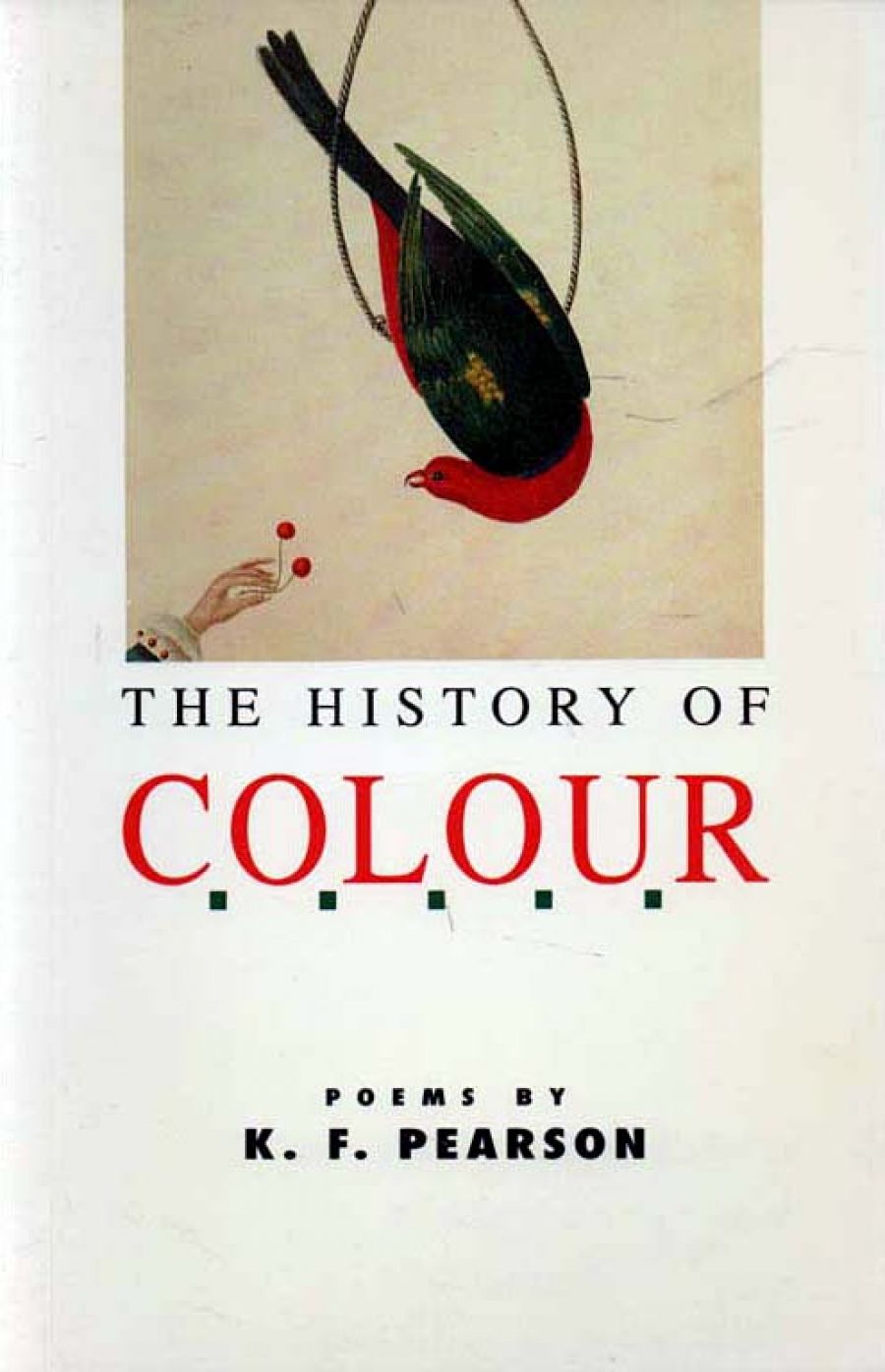
- Free Article: No
- Review Article: Yes
- Online Only: No
- Custom Highlight Text:
One of the strengths of this, K.F. Pearson’s second collection, is the range of the poetry it contains: both geographical – from Adelaide (and suburban Adelaide at that) through Polynesia to the Arabian Gulf; and historical – moving between the present and Quattrocento Italy.
- Book 1 Title: A History of Colour
- Book 1 Biblio: Collins A&R, 78 pp, $12.95 pb
‘An Application for Assistance’ picks up on the most longstanding of issues – that of patronage. ‘Since my poems and inspiration I’ve acknowledged to you, Medici’, Politian writes, ‘and my every talent is at your service / ... send your clothes as a gift to me at once’. Fairly blunt. I was reminded of the controlled invective of Samuel Johnson writing to Lord Chesterfield.
Although there are good poems elsewhere in The History of Colour, no other section achieves the sustained high standard of ‘Autobiographical Moments’. Nevertheless, there is considerable poetic ability on display.
Poems such as ‘Port Elliot Magpie’ or ‘Entrance Ceremony’ are made notable by Pearson’s sharp eye for detail. There are many shrewd observations: for fishermen, ‘the horizon (is) ... the pinnacle of desire stretched flat’. A number of poems are enlivened by subtle touches of humour. The voice that runs through these poems is a colloquial one, though he often successfully contains this voice within poems of heightened rhythm and controlled structure. A poem such as ‘Ginifale’ demonstrates Pearson’s range, with its evocation of the Polynesian myth, the control of tone and the neat parallel of the whale to the pregnant woman.
But balancing these considerable strengths are a number of weaknesses that tend to mar one’s appreciation of the collection as a whole. Some of the poems here feel to me as if they need more work. The perceptions and the inventiveness are there, the ability to see the everyday world from new perspectives, but some suggest that the poet has been too easily satisfied. A number of poems have benefited from being workshopped, or at least looked at with the eyes of a critic. In ‘Of the Critic’ Pearson denies the value of such people, suggesting at best, a ‘shadow glory’. I would suggest, however, that a critic’s eye before some of these poems went to press would have strengthened them considerably.
For example, ‘The Death of the Bird’ recalls A.O. Hope’s poem of the same name, and that comparison underlines the extent to which some of Pearson’s poems are under-developed. In The Cave and the Spring, Hope discusses his poem, and mentions the fact that it took him four years to complete (some of his poems took much longer). He began the poem, Hope tells us, but could not see how to finish it, so he put it aside. When he came back to it four years later, the missing conclusion suggested itself fairly promptly. Pearson’s poem, like a number of others in his collection, might well benefit from such time to mature.
The weaknesses in such poems include an overreliance on modifiers (‘A Drum This Time’, ‘Sea Urchin Shell’, ‘Fiji’; a reliance on abstractions and/or rhetoric (‘The Economy of Fashion’, ‘Four Glasses’ or ‘A Thing is Event’); line endings that seem arbitrary (‘A Touch of Green’, ‘The Eye Does Make It So’ or ‘The Peachin Fad’). There are also occasional lines which remind one of a New Statesman competition in the way they state the obvious: ‘the river still moves at a watery pace’, ‘The scarlet anemone will not be like the settled/world of blue plates on a dresser’ or When the fish begin to swim, the fish begin to swim’.
Some of the poems are very slight: ‘Stamps on Metal’, ‘Island Suite’, ‘A Feather’ among them. Sometimes you leave these slight poems with a sense that there is nothing more to say, that the poem is as complete as a Japanese Haiku. More often though there’s the unsatisfied sense that the poet has barely scratched the surface.
The title for the collection comes from ‘An Um in a Private Collection’:
But the history of colour is fraught with shade, and the time of day, the
turn of the earth;
and recession of removal’s not
complete, if that underlying cerulean,
sky-subtle tones beneath the glaze’s
skin,
veined by your regret that the world’s
constructed thus,
partly kindles the original blue.
This poem demonstrates many of the strengths and weaknesses of the collection as a whole. Here is the eye for detail, the sense of relevance of the past to the present, the colloquial voice that works quite effectively with the heightened rhythms of the verse. But here also are the ‘abstractions, the over-dependence on modifiers, the resort to rhetoric which tend to attenuate many of the poems.


Comments powered by CComment